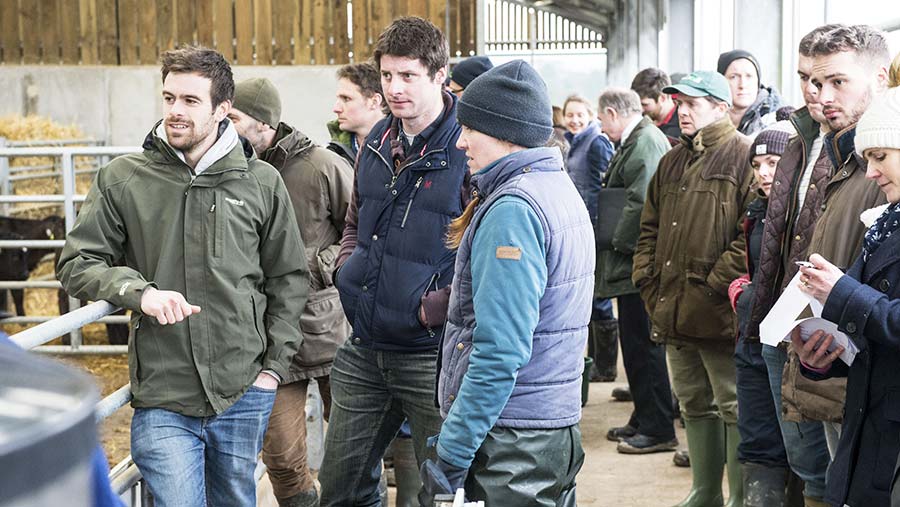Rethinking cattle performance: Improving dairy beef management
 © BillyPix
© BillyPix Farmers heard how important milk management, health and housing strategies are to maximising calf performance at Farmers Weekly’s first Rethinking Cattle Performance workshop.
The first Rethinking Cattle Performance workshops, in association with Zoetis, Volac and ABP, focused on dairy beef calf management and took place at Jo and Steve Pile’s farm in Wiltshire, where they rear dairy beef cattle.
Read the report from the event and watch the video on housing below.
Milk management
Feeding a calf up to 900g of milk replacer daily may be needed to achieve optimum daily liveweight gains of 0.9kg, a veterinary specialist in cattle health and production has said.
If milk replacer intakes are restricted, calves will seek energy from other sources and eat more concentrates, but this may limit growth as starter is a less efficient energy source.
See also: Rethinking cattle performance workshops

Farmers at the Rethinking Cattle workshop © Billy Pix
“Calves must consume one and a half times more dry matter from starter versus milk replacer to achieve the same daily liveweight gain,” Andrew Henderson, veterinary consultant with the Evidence Based Veterinary Consultancy, told farmers at the event.

Andrew Henderson © BillyPix
Published research indicates higher milk intakes aid forestomach development, leading to improved feed conversion efficiency during the pre-weaning period.
Achieving higher milk intakes
Greater intakes could be achieved by feeding 6 litres/day mixed at a concentration of 150g/litre, advises Andrew Henderson.
He recommends avoiding feeding concentrations greater than 150g/litre as the latest research suggests this may be a risk factor in the development of abomasal bloat.
“I would advocate following manufacturers’ indications regarding concentration of powder fed, though these may be lower than necessary to achieve optimal growth rates,’’ he cautions.
In very cold conditions, a calf may need more than 900g/day.
Mr Henderson says this would be best achieved by increasing the volume fed or the frequency of feeding – in the case of a twice-a-day feeding system increasing feeding to three times.
Feeding more frequently and allowing larger volumes to be consumed overall mimics natural feeding behaviour, Mr Henderson suggests.
“If calves are given the option they will feed at least three times and possibly up to 12 times a day, taking small volumes at each feed.
“Calves on restrictive systems present with indicators of poor welfare such as increased vocalisation and unnatural behaviours.”
Milk intakes are important even when calves are scouring.
Feeding calves with scours
At Cats Hill Farm, where Jo and Steve Pile rear more than 1,400 dairy-beef calves annually for Blade Farming (part of the ABP Group), milk is not withheld from a calf when it is scouring.
The farm’s vet, Tim Potter, who is also the vet adviser to Blade Farming, said a scouring calf could need as much as 10 litres of liquid daily.
“A lack of fluid kills calves, we would never withhold milk from a scouring calf.
“They need a set volume every day and if they are losing fluid out of the back end that needs to be replaced over and above normal intakes.’’
Scouring calves at Cats Hill Farm are given electrolyte mixture in 2-litre doses to boost fluid intake.

Jo Pile © BillyPix
“Electrolyte therapy doesn’t have enough calories to keep the calf going. Keep the milk levels the same but always give electrolytes alongside,’’ Dr Potter recommends.
“If you are feeding twice daily add an electrolyte feed in the middle of the day and one at the end.’’
Fluid therapy is the most critical part of treatment of calf scour, whatever the cause.
“Calves are less likely to respond to other treatments if they are dehydrated,” says Dr Potter
Reducing infection
Fluid therapy is also used alongside pneumonia treatments to support unwell calves at Cats Hill Farm.
Mrs Pile has an isolation pen for sick calves and by removing a calf from the group to treat and monitor fluid intakes, it is possible for a calf with acute pneumonia to recover in just 12 hours.
The pen has a deep, dry straw bedding with heat lamps and calf jackets used when needed.
“When an animal is sick it can get knocked around by the rest of the group, but an isolation pen provides a warm and quiet environment for the calf while giving treatments time to work,” said Mrs Pile.
“It means I can monitor them much easier and can see how much fluid they are taking in.”
Isolating a sick calf also protects the rest of the group from infection.
Disease detection
Disease detection is key to picking up signs of illness at an early stage, says Mrs Pile.
The health protocols at Cats Hill Farm operate to the same high standards common to the pig and poultry sector, with animals kept as distinct batches.
Any animal that isn’t performing remains with its original batch.
“An animal is not held back or moved between batches because if it was it could transmit disease through all the stock,” says Dr Potter.
That animal is managed in the isolation pen or within its original group.
Taking the temperature of a calf that appears to be off-colour is a standard practice.
“Taking the temperature of animals that you are a bit unsure of will give a much better indication of whether you need to go in with treatment,” said Mrs Pile.
“I regularly check the calves and can pick up on when something is wrong at a very early stage and treat straight away which is having a really big impact on reducing infection and treatments.’’
She walks through the pens for a final check at 11pm and any calf that the computerised feeders flags up as having not fed is given a bottle of milk to provide overnight nutrition.
Infection is a risk in a system where there is a regular turnaround of calves so there are strict health protocols in place across the system to minimise disease risk.
Vaccines
When the calves arrive as two week old, they are given vaccines for pneumonia and ringworm.
They also receive electrolyte treatment on arrival. “Transport is a stressful period so an electrolyte treatment at this stage will help them overcome any fluid losses and give them the best possible start on the unit,” says Dr Potter.
Efficacy of vaccines is improved if stress factors are limited.
“We group together jobs likes debudding, castration, weighing and treatments to keep stress levels to a minimum, we do everything as quickly and quietly as we can,” says Mrs Pile.
Using anti-inflammatory pain relief at dehorning and castration means there are fewer complications and no growth checks.

Tim Potter © Billypix
Dr Potter says in a climate where there is great pressure on the farming industry to reduce antibiotic usage, caution is needed to avoid late treatment.
“At what stage do you go in and treat? We must be careful not to take steps too far away from treatment because if disease has time to establish it can result in more antibiotics being used in the long term.”
Mrs Pile says early treatment had resulted in fewer treatments.
Potential infection from drinking water is reduced by having individual drinking bowls which are emptied and cleaned daily.
Although the ideal is to have a drain under water bowls, Mrs Pile says a bucket placed under the bowl to catch the dirty water at cleaning prevents moisture build up.
“Water needs to be fresh and clean, you can’t expect calves to drink it if it is stale and dirty,” says Mr Henderson.
Calves need 4-4.5 litres of clean water for every kg of concentrate intake, over and above the liquid in calf milk replacer intakes.
Housing
Calf health and performance can be improved by correcting weaknesses in existing housing.

Jamie Robertson © Billy Pix
Dr Jamie Robertson, an expert in livestock housing design, warns that many buildings don’t feature key principles for keeping youngstock healthy.
He explains that the environment in livestock sheds is controlled by three separate factors – fresh air, moisture and air speed.
“Poorly ventilated buildings are very expensive buildings to run. Either the stocking density must be low or the bedding costs will be high,’’ says Dr Roberston, an honorary research fellow at the University of Aberdeen.
Bugs thrive in moisture and areas of damp, leading to animal health problems including pneumonia and scours.
To assess a shed’s ventilation status, Dr Robertson recommends activating a smoke bomb, which can be purchased from a plumbers’ merchant. This will give a good visually indication of air movement in a shed.
Watch the video to see more from Dr Robertson on the issues affecting housing and environment.
Tips for buying in calves
- Weight at two weeks of age is a good predictor of how calves will perform on rearing systems. Mr Henderson recommends targeting 50kg for a native-type calf and 53kg for a Holstein.
- Calf health is underpinned by early intakes of good quality colostrum in the correct quantities so for units that rear calves, it is important to source from farms with good colostrum management protocols.
- Research has shown that a calf is two times more likely to die if it has not received adequate colostrum, says Mr Henderson. “Source from someone you are confident is doing a good job of colostrum feeding. “You will have an inefficient system and you will have disease if calves come from a farm with poor colostrum management.’’
- Colostrum quality is also compromised on systems that pool colostrum, Mr Henderson adds.
Thanks to ABP, Zoetis and Volac, whose sponsorship made it possible to run this Rethinking Cattle Performance workshop. Farmers Weekly had full editorial control of this article.
Sponsors’ message
“ABP, Volac and Zoetis are committed to supporting UK cattle farmers in running enterprises that produce healthier, more productive animals.
Part of this commitment means working with organisations such as Farmers Weekly on initiatives such as the ‘Rethinking Cattle Performance’ campaign, to offer farmers the opportunity to learn from experts and their peers about the best ways to produce cattle, and particularly calves, as efficiently as possible.
Find an event near you
Farmers Weekly is running three more Rethinking cattle performance workshops. Find out more on the Rethinking cattle performance website.
